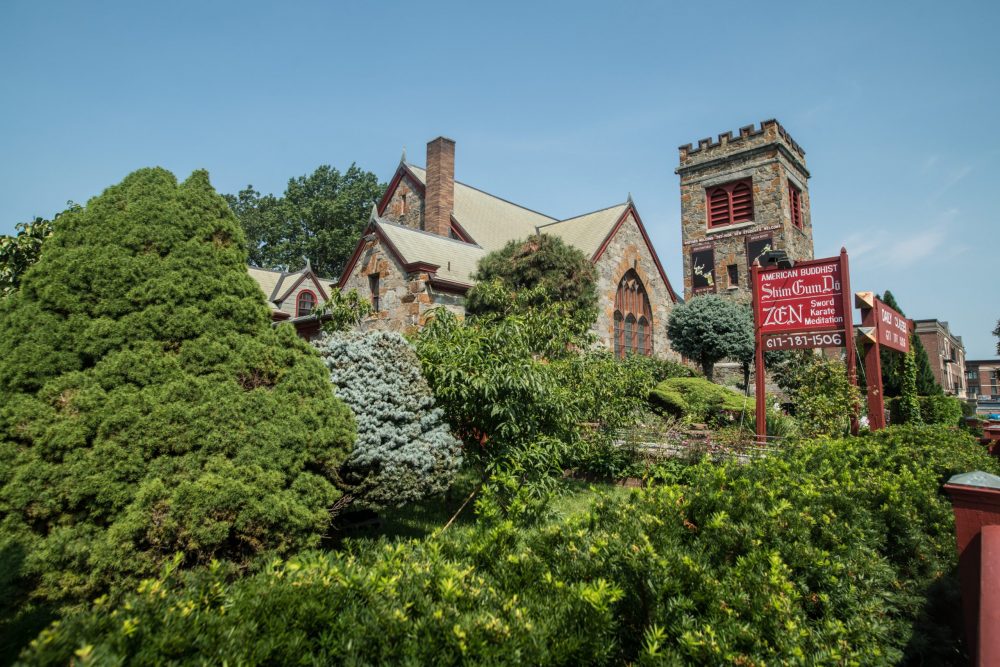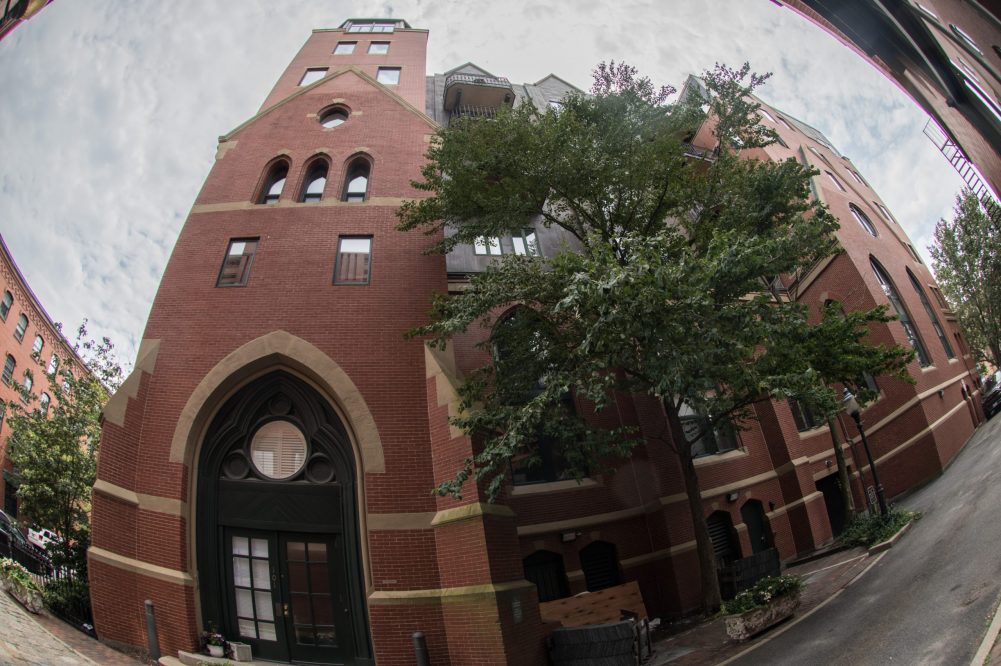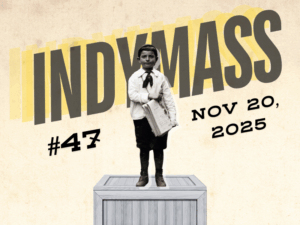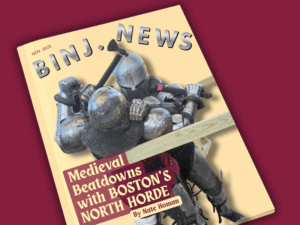As more and more former Boston churches are being converted into luxury housing, is the city missing out on potential arts and community spaces?
BY CLAIRE SADAR AND ALYSSA MALDONADO-ESTRADA
Photos by Derek Kouyoumjian
The iconic Coolidge Corner Theatre was opened in 1933 in what was once the Beacon Universalist Church, but it wasn’t always as beloved by all as it is today. Proposals to open the theater faced strong resistance for decades, especially among the Christian clergy. The Coolidge’s redesign as a theater almost completely masked its sacred origins; walking into its lobby or main theater hall today, you’d be hard-pressed to find anything marking it as a church, yet the bones of its former incarnation still support the building.
The Coolidge is one of the earliest, if least visible, examples of a phenomenon that has become commonplace in Greater Boston in the last decade—that of the redeveloped former church. The early 1980s saw the first batch of churches being reused for a variety of other purposes in the Boston area. Some became condos, others community arts centers or dojos. However, as the number of vacant churches rapidly increased, alongside the price of housing in Boston, almost all vacant church buildings that have come on the market in Boston have been snapped up by developers and reborn as luxury condos.
The story of church conversion in Boston mirrors the way our city has changed over the last 30 years—the gentrification of neighborhoods, the dwindling rates of church attendance, the reckoning with widespread sexual abuse in the Catholic Church, the skyrocketing rent, construction, and housing costs. As more and more churches come on the market, and many are slated to become luxury condos, it is important to understand the options for and restrictions on repurposing and preserving these beautiful and historic but often prohibitively expensive-to-maintain buildings.

Jesus and Buddha shake hands
Churches are sold and desacralized for a variety of reasons: fire destroying sacred edifices, dwindling congregations paired with old buildings that have high maintenance costs, congregations moving to different neighborhoods, and parish consolidations and closures.
Some of the earliest churches to be turned into condominiums were ravaged by fires that left the buildings gutted. In July 1978, Mount Vernon Congregational Church in Back Bay burned in a five-alarm fire. At the height of the blaze, parts of the church collapsed. Its stone arches and tower survived but the fire destroyed the building’s roof. In 1983, architect Graham Gund transformed it into a 38-unit luxury development with brick construction that integrated the surviving arches and towers.
Clarendon Street Baptist in the South End met a similar fiery fate in 1983 when a nine-alarm fire destroyed the 19th-century church, leaving only some of its exterior walls standing. This final fire was the third in the church’s history—it was seriously damaged in an 1874 fire, and again in 1912 when flames lit up its rose window and destroyed the roof, auditorium, and pulpit.
By the 1980s, the church fell vacant. Another congregation had bought the building and had started renovation when a 1982 fire destroyed their hopes for a new home. But from these ruins came condominiums when Finegold Alexander Architects used the shell of the church to build 60 units. The firm today prides itself on its “reinvention of yesterday’s landmarks for today’s needs.”
Diocesan budgets and mergers also prompt church sales and conversions. According to a report from Georgetown University, between 2000 and 2010, 1,359 Catholic parishes closed as parishioners aged, Mass attendance declined, and cash-strapped dioceses struggled to maintain deteriorating buildings. One of these churches was Holy Trinity German Catholic Church in the South End, which the archdiocese shuttered in 2008. Parishioners formed a preservation group hoping to save their church, but the archdiocese sold the building to New Boston Ventures for $7 million in 2014. The building became the Lucas, a 33-unit luxury condominium where units with high-end finishes and high-tech smart home systems cost up to $4.8 million.

In the early days of church conversion in Boston, deconsecrated churches were just as likely to be used for other religious, private, or public purposes. In the South End, a former Lutheran church served as the Villa Victoria Center for the Arts for more than 30 years, from 1986, until the unsafe nature of the building forced it to close in 2019. The structure was demolished late last year due to the extensive and expensive nature of the repairs that were needed. A new center is being built from the ground up and will open in 2025.
The First Parish Church in Brighton was built in 1894 on Chestnut Hill Avenue at a time when its stone, castle-like facade stood alone on a ridge and was visible from every direction. In the 1940s, now hemmed in by the expanding neighborhood, it was leased to a masonic group to use as a lodge. By the time the late 1970s rolled around, few changes had been made to the building, but not much had been done to maintain it either. “It looked like ghosts lived here,” Mary Stackhouse, head master of the Shim Gum Do Association, said in an interview.
Great Zen Master Chang Sik Kim, the founding master of the Shim Gum Do Association and Stackhouse’s late husband, bought the building to house his martial arts and Zen Buddhism teaching center in 1981. Its former life as a church was actually part of the attraction, according to Stackhouse. “There was an idea to find a building that would suit the idea of a temple,” she said.
The founding master felt the building had good energy and the Christian elements, far from being a liability, were an asset.
“Jesus and Buddha shake hands,” he told a student worried about the stained glass windows depicting Jesus, according to Stackhouse. One of those windows remains visible in the building, and is now paired with a Buddhist temple guardian. A large stained-glass window of Jesus at the altar end of the building was restored and stabilized by the Shim Gum Do Association, and it’s now hidden by a large Buddhist altar that replaced the Christian one. Overall, the association did very few major renovations, and primarily restored the building, as the large open spaces for worship and teaching met its needs nicely.
“Not particularly adaptable”
In contrast to the minimal changes needed to transform an old church into a martial arts training center and Zen temple or a community arts center, retrofitting a church building to create multiple living spaces is a difficult, involved, and often destructive process.
“The challenge in churches is given the volume within the church. … They don’t easily lend themselves to conversion into housing units because you’re typically often having to add floors, add a lot of partitions. … There’s also restrictions usually on the historic side in terms of what could be done with the properties as well,” said Bill Grogan, president of the Planning Office for Urban Affairs, a social justice ministry of the Archdiocese of Boston. The POUA has developed 3000 units of mixed use and affordable housing in the Boston area over the last 50 years. “Looking to find a way that a unit can be marketable from a design perspective is challenging,” Grogan added.
The POUA developed the former St. Aidan’s Church in Brookline, where President John F. Kennedy was baptized, into nine luxury units, and used the rest of the property around the church to create a complex of mixed rate housing, including many units designated as affordable. It was only because the market in Brookline could support a $1.5 million price per unit that they were able to redevelop the church itself into condos. Even as a nonprofit developer, the POUA was only able to recoup its cost at this steep price tag.
“I want to see every church and church building [that is sold to a developer] turned into some type of affordable and mixed income housing, because that is reflective of our mission,” Grogan said. “That bumps up against the reality of the financial situation churches and the archdiocese find themselves in. … Not all churches can necessarily be converted into affordable housing. It takes some creativity to find that mix. As we were able to do with St. Aidan’s.”
Many condos in former church buildings are not only prohibitively expensive to buy or rent, but can be unaffordable to maintain and awkward to live in. Christopher Lehrich lived in a condo with his family of four in the former St. Mark’s Methodist church for approximately four years. He had an architect/designer help them strategize as to how to best maximize the use of space in the awkwardly apportioned unit—one that was long and thin, had minimal light, little ventilation, extremely high ceilings in some rooms, and weirdly shaped spaces in others. These features were common to all church conversions, the architect told him.
The architect that worked on the Mt. Vernon Congregational Church, Graham Gund, echoed the problems Lehrich encountered. “A typical church plan is not particularly adaptable to housing because you need light and access to the outside. The walls are often quite thick, and inside you end up with a lot of space that’s hard to use,” Gund told the Boston Globe in 2015.
The biggest problems came with trying to maintain the unit, and with the building itself.
“The vaulted ceiling … if there were [leaks], it would have been fabulously expensive, as no normal workman could work on that ceiling, as they aren’t insured enough,” Lehrich said.

Landmark status
Part of the problem is that many, if not all, of these buildings have some sort of historic or landmark status, so renovations and repairs must be done in a way that preserves the character of the building. This can be prohibitively expensive for individual unit owners. In addition, any repair that is needed to an exterior or structural unit affects the entire building. So you have a complicated situation involving ostensible individual ownership but collective consequences. If the rose window that Lehrich had in his unit had leaked, it would have been extraordinarily expensive to fix, but not fixing it would put the whole window in danger of crashing down.
“I feel like the way this conversion was done was like an elaborate flipping,” Lehrich said. “The point is to do the work, sell the property, and walk away. You cannot do that with these buildings. There’s a long-term project here. It has to be maintained.”
Despite these vast issues with living in a building that was never meant to be lived in, church condos continue to sell. When you have reached a level of financial, professional, and personal success, living in a beautiful, historic building offers a level of cultural cache that is not obtainable through an ordinary luxury condo. According to Nicolas Lynch, who studied the reuse and marketing of a former church building in Toronto, “developers, in concert with architects, public relations firms, and marketing and real estate agents, repolish churches with a contemporary patina to restore and emphasize not merely the economic capital of the building but also its new cultural capital.”
Leslie Warshaw technically also lives in a historic converted church, but her unit and experience is very different from Lehrich’s. Warshaw lives in the former Clarendon Street Baptist Church, in an apartment that is entirely outside of the historic brick structure. When the church burned down, its roof was destroyed. The developer added a structure above the roofline of the old church, creating several more floors of livable space.
Speaking in her comfortable living room, Warshaw said she bought the unit at first sight in 1989 and hasn’t ever regretted her purchase. As a native of the Bronx, she was attracted to the neighborhood’s cultural and economic diversity at the time she bought it; the area reminded her of her childhood neighborhood. In the time since, she has become somewhat dismayed by the encroaching gentrification, but said she would never consider selling. When asked why, she motioned toward the massive windows, and the full western view above the rooftops of the South End.
“That view,” she said.
That view is only attainable through the kind of full-on gutting of a building that happened by accident in the case of the Clarendon Street Baptist Church. In contrast to the conversion of St. Mark’s, which maintained the whole of the building, most developers are now following the model of the Clarendon. The problems Lehrich described—the lack of light, ventilation, awkward spaces—are partially mitigated by the trend in the latest church conversions: removing the roof and all of the interior structure and dropping a large steel and glass box into the middle of the church shell. This new superstructure not only creates more units, but more units with good light, ventilation, and layouts. (Finegold Alexander—the design collective behind the Lucas, the former Holy Trinity German Catholic Church in the South End, which was one of the latest and largest conversions in this style—have images of the church in the middle of the rebuild process on its website for the project.)
At a recent hearing held by the Bay Village Historic District Commission (part of the Boston Landmarks Commission) on the redevelopment of the former Our Lady of Victories Church, Finegold Alexander proposed a plan similar to luxurious Lucas, with a large glass and steel box rising from the sanctuary, but on a smaller scale with 18 units. The commission accepted the plan with cosmetic changes, making it extremely likely that work will soon commence.
Notably, the Our Lady of Victories project will include two units that will be sold as affordable, according to the city of Boston’s definition. In many cases, the lack of affordable units in these church conversions has become of increasing concern to local activists, particularly in regards to the former Blessed Sacrament Church in the Hyde Square area of Jamaica Plain.

The JP theater
The Jamaica Plain Neighborhood Development Corporation acquired Blessed Sacrament shortly after it was closed in 2004. The church was one of the 74 closed by the archdiocese that year, in the wake of the reckoning over systematic sexual abuse throughout the Catholic church. The development corp developed 80 units of affordable and market-rate housing, as well as a martial arts and youth center, on the church’s former campus.
The church building itself remained undeveloped, but not for lack of trying. The Boston Landmarks Commission provisionally approved a plan to convert the church into condos in 2006. The initial plan was to turn the church into a co-housing complex, small private units clustered around shared living spaces, but this soon changed into straight market-rate housing. Residents pushed back at this change due to concerns about rising housing prices, and in 2014 the Hyde Square Task Force purchased the still empty building with the plan of turning it into an arts and cultural center.
But the money needed to follow through with this plan turned out to be much more than HSTF anticipated. In 2019, they attempted and failed to engage a development partner and ultimately decided to sell the building. Like the Jamaica Plain Neighborhood Development Corporation before it, the HSTF has been widely criticized for its handling of the property and its subsequent sale. Pat Feely, one of the local activists leading the effort to prevent the creation of luxury condos in the church, wrote in an email, “Blessed Sacrament is a particularly important site in an area of JP certified as the Latin Quarter… It also is an area of JP which has not yet incurred the level of displacement that much of JP (and Boston) has.”
In an email and followup phone interview, Celina E. Miranda, the executive director of the Hyde Square Task Force, defended the selling of the church.
“The process has not been perfect, but what I hope people keep in mind is that we have stayed true to what we told the community we would do in the meetings we held in the fall of 2020,” Miranda said. “We have taken our time to get the best proposals possible and have prioritized bidders that understand the significance of the building to the community.”
At the time of this reporting, the HSTF had three bidders, which had not yet been presented to the community. Miranda said the proposals would be released to the public soon and provided a letter that would go out. The correspondence includes the dates of the community meetings via Zoom and an open house, which will lead up to the HSTF’s board of directors voting on which option to move forward with in October.
Miranda said the three proposals that the Task Force would present to the community would be: 1—An option for market-rate condos that would include a space for community use; 2—An independent school with assembly space that the community can use; 3—An affordable and workforce housing proposal that includes community space.
The local outcry over the sale of the church did have an influence on the way the HSTF has approached the bidding process.
“When we announced in May 2020 [the sale of the building], we heard loud and clear from that meeting that the community wanted more information to understand how we arrived at that decision,” Miranda said. “At that point we did pump the brakes and took the time to organize a series of six community meetings. … From there, we have continued to keep in mind what we heard in May 2020.”
Asked about why a proposal for market-rate condos was chosen as a finalist, despite community outcry against such a use for the building, Miranda said the task force focused on the community benefit of the proposal and the previous work that the developer had done in Jamaica Plain: “We have a good affordable housing stock in the area. We are committed, as the managing partner of the Latin Quarter, to continue to make sure that we have public spaces … and to preserve the rich history of the neighborhood.”
Even with a community space, turning the majority of the building into market-rate condos is likely to raise the ire of activists.
“I have lived near Blessed Sacrament for over 50 years, the surrounding neighborhood has always been mixed in terms of income, ethnicity, and age,” Pat Feely, the local activist, wrote in an email. “To many of us, Blessed Sacrament is still a symbol known for providing and organizing for the good of the local community. What would be harmful would be any ‘luxury’ development that would perpetuate the overwhelming gentrification of so much of Jamaica Plain.”

Church and state
Feely and other activists who are pushing back against luxury developments aren’t merely acting out of passion, though that appears to be part of it. They also have data to back up many of their points.
Despite assertions by economists and politicians that any new development will help ease rising rents in an area, this is not necessarily the case. For renters at the lower end of the scale in a neighborhood, adding luxury units does nothing to ease rents, while existing units with high or mid range rents will see only a 1% rent reduction per 10% more housing stock added.
Logan Mohtashami, a housing data analyst and lead analyst for HousingWire, said the only way to ease rents for the lower third of the market is to build more units at this price point: “The lower end will always be rising based upon what people can afford. And they don’t get a break ever, because they don’t build cheap rentals. … You just need to build a lot of cheaper, not high end, rental units, so we can keep the supply there going and that will be the best thing to cool down [the market].”
“What you need to do is have the [federal] government jump in and finance that kind of building, because the states and cities don’t really have the budget. If you get a developer, they want to build high end. So you need a partner that doesn’t have financial issues and can just cut through the regulations and build,” Mohtashami said.
It seems unlikely that the federal government will step further into affordable housing in quantity in places like Boston anytime soon. If anything, the trend is moving the other way, towards privatization. All things considered, nonprofit developers are currently the best solution to the need to build more affordable housing in our region. The POUA and another affordable housing developer, Preservation of Affordable Housing (POAH), have in recent years worked with houses of worship on one creative solution that helps preserve church buildings and creates more affordable housing in places that need it most. Both organizations are currently working to redevelop currently vacant or underused buildings and land owned by churches into affordable housing. The projects will allow churches that own the property to draw an income either directly or indirectly from the new rental units—an income that will help support the maintenance of the existing building or the rebuilding of a new chapel, for example.
The cost of land on which to build affordable housing is what initially motivated the POUA, the affordable housing nonprofit associated with the archdiocese, to look at potential collaborations with parishes that had empty buildings or own property. The POUA is currently working with St. Catherine’s Parish in Nubian Square and the city of Boston to expand the footprint of St. Catherine’s onto a parcel of adjacent city land to create a larger development that will include mixed income rental and homeownership housing and a new chapel space for the parish.
The other affordable housing developer interviewed for this piece, the POAH, is currently working to redevelop the former Sacred Heart Rectory, School and Convent buildings in East Cambridge to 46 mixed income units. The POAH will lease the land under the buildings it is developing into apartments from Sacred Heart, and “our lease payment goes directly to that church, and allows that church to exist in a time when the funding for the work they want to do and the programs they want to do is pretty limited,” said POAH Senior Vice President in Acquisitions Julie Creamer.
“For us, it’s absolutely an opportunity to do the two things we do best, and that is to develop affordable housing and make sure it is long-term affordable housing and to really preserve the beauty of the neighborhood, and to preserve what makes a neighborhood unique, and that’s not just the buildings, but the people that live there,” Creamer continued. “You could never replicate the beauty of this building as an affordable property.
“We have a unique opportunity here to say that we can make beautiful, affordable housing. The cost of materials to build ground up is getting exceedingly more expensive. For us, this gets us to a point where the building is there and the real cost is in the details … and making sure the units are built to our standards as far as energy efficiency and livability,” said Creamer. “We could never build the standard that is there today as affordable housing.”

Church of the almighty dollar
Every conversation that was had and interview conducted in the course of researching this article circled back to the same thing: money. Unaffordable maintenance costs, the rising cost of construction, the price of the condos in the buildings, the rents in the surrounding neighborhoods, and the unaffordability of the greater Boston area in general. The market can sustain building luxury condos, but because of the high cost of construction, it is also presently extremely difficult to repurpose churches for anything other than luxury condos without losing money.
When Stackhouse’s late husband bought the church that now houses the Shim Gum Do center, he was able to negotiate down the price. Now, Stackhouse has been contacted by several developers looking to buy the property, telling her it’s worth a fortune (she is resolute that she won’t sell the building). If the church that is now the Coolidge Corner Theatre was up for sale today, there is no chance it would become a nonprofit community theater.
Blessed Sacrament may become a new model for redeveloping a church with community input and needs in mind, but only time will tell if community input is taken seriously in choosing the bidder for the property. Some churches with additional property or buildings can leverage their assets to both create affordable housing and bring in desperately needed income to preserve the building, but many smaller churches and those in more tightly packed areas of the city don’t have this option either.
What is certain is that the future of these landmarks and former centers of the community must be considered beyond their simple monetary value as real estate in one of America’s most expensive cities. In one case that sadly seems to be a harbinger of things to come, the Ebenezer Baptist Church in the South End is slated for development.
The church, which was founded by formerly enslaved people who made their way from Virginia to Boston’s South End in the mid-19th century, is likely to be redeveloped as luxury condos.
It’s another space where a conversion will inevitably raise questions around race, gentrification, and historical erasure that have yet to be properly addressed and reckoned with by either Boston’s leadership or the community at large.
“The city has come up with some good resources, but policy changes are what is needed in conjunction with resources,” said Pat Feeley, the Jamaica Plain activist. “Much better city policies about saving and building truly affordable housing could have saved a lot of diversity in terms of income and ethnicity in areas that have experienced such a loss of Boston workers.”
This article, part of a three-part series, was made possible in part with support from Sacred Writes, a Henry Luce Foundation-funded project hosted by Northeastern University that promotes public scholarship on religion, and was edited in collaboration with the Boston Institute for Nonprofit Journalism and DigBoston.








